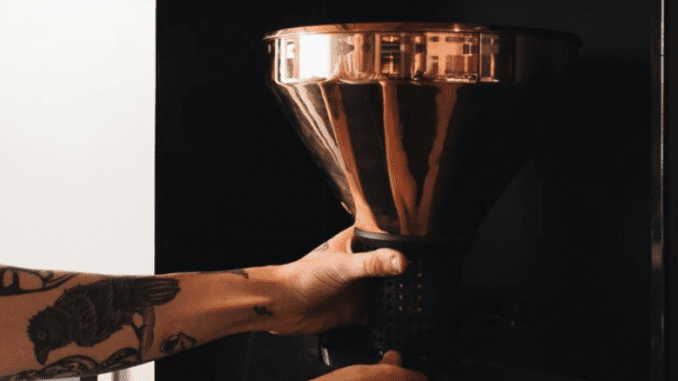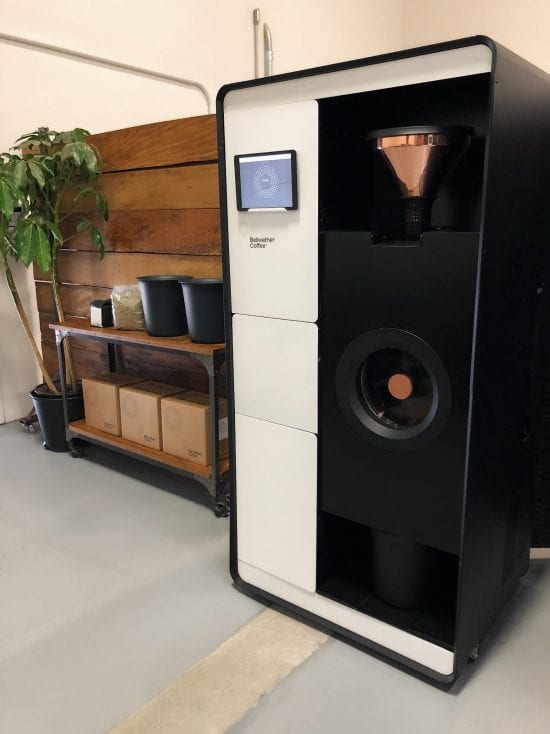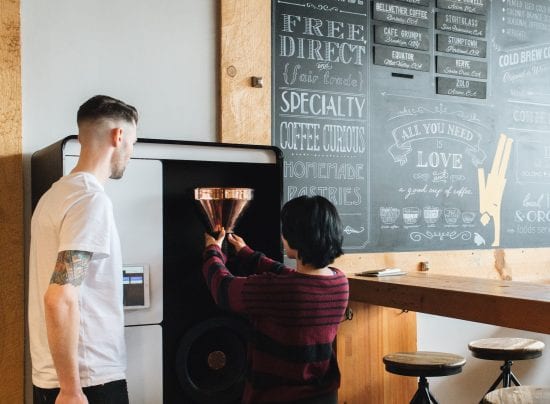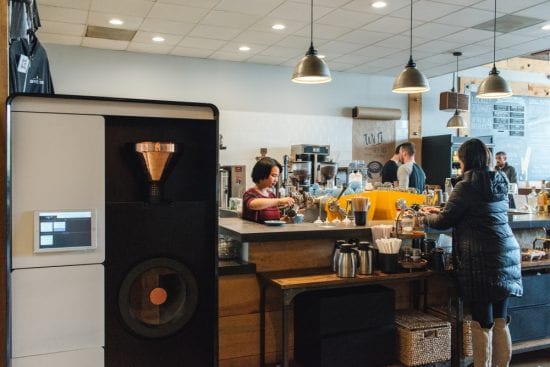
Started as an idea five years ago, the novel roasting concept has now come to market, with the 100 percent electric, ventless roasters now hitting cafés and grocery stores.
BY CHRIS RYAN
BARISTA MAGAZINE ONLINE
Photos courtesy of Bellwether Coffee
This summer, a sleek, rectangular-shaped contraption began popping up in a handful of cafés, most of them located in the San Francisco Bay Area. The function of this box-like device—with its rounded curves, copper accents, and touch screen in the front—may not have been immediately evident to the customers in the shop. But in reality this machine was the driver behind each café’s roasting programs, turning green coffee into the freshly roasted product customers were enjoying.
This device was the brand-new electric, zero-emissions roasters from Bellwether Coffee, which began being placed at cafés in summer 2018. It has been a long journey for the Berkeley, Calif.-based start-up, which was launched in 2013 and is now making its way into coffee businesses and grocery stores, with a backlog of orders into 2019. Billing itself as the “industry’s only source-to-service partner,” Bellwether is hoping its mix of ease of use, freshness, cutting-edge technology, and more takes off with businesses and their customers.
How it started
Ricardo Lopez had the idea for Bellwether back in 2013. A veteran of the wine and tech industries, he noticed that coffee was embarking on a similar path to the one wine had traveled: a move to higher-quality, increasingly complex tastes, embracing innovation and new technology, and the farm-to-table movement.
Ricardo felt that more cafés could be roasting in-store to show off the hand-crafted nature of the product. He talked to café owners and learned some of the reasons they weren’t roasting, including the need for gas lines and venting (which require permits); the size of traditional roasting machines; and high upfront capital costs. “This led to the idea,” says Nathan Gilliland, CEO of Bellwether, “what if we could build a roaster that removed all of those barriers and also roasted delicious coffee?”

Moving into stores
Fast-forward to 2018, and that roaster has come to life. About the size of a standard-size refrigerator, the Bellwether roaster is a compact, self-contained machine that plugs into a power outlet. Cafés that purchase Bellwether roasters pay for them on a monthly basis. Controlled by a private-use iOS app, the roaster features a touch screen through which the user can access a green coffee marketplace, inventory management, roast scheduling tools, and more.
Kimberly Noon, Bellwether’s VP of marketing, says perfecting the technology behind the Bellwether roaster was one of the lengthiest parts of developing the product. “While it took us many years to get the technology right, we’re very happy with the result,” Kimberly says. “That said, just like any other hardware and software product, we’ll always be innovating, finding new ways to perfect the technology, and making sure our product is exactly what our customers need it to be.”

An aim for sustainability
Bellwether Coffee strives for sustainability with the roasters in more than one area. From an environmental perspective, the emissions-free roaster bills itself as “the lowest carbon footprint roaster ever built.”
But Bellwether also strives to make an impact in coffee-growing communities as well. With its built-in green coffee marketplace, the Bellwether roaster allows users to order green coffee Bellwether sources from its importer partners, which include Sustainable Harvest and Royal Coffee. “The key for us is working with companies that are aligned with our values around quality, transparency, and positive impact for the farms they represent,” says Kimberly.
Bellwether also aims to impact coffee communities through its Tip the Farmer program; when customers pay for their coffee via POS at cafés using Bellwether roasters, they have an option to give an additional tip to the farmer who grew their coffee. “We’ve known from the beginning that to create real positive change in the coffee industry, we’d need to do so at the farm level,” says Ricardo, Bellwether’s founder. “While discussing ideas around sharing the wealth with coffee farmers, we thought, ‘Why not just have customers share the wealth with farmers directly?’ The financial impact can be incredible—if one in 20 consumers tips a farm $1, the farm could more than double their average revenue per pound.”

Looking forward
With the Bellwether roasters now out in the world and a steady backlog of orders, the company is looking forward to more businesses and customers getting a chance to experience the roasters. And with an additional $10 million of venture funding secured this summer, the company should be well positioned to continue that growth.
Nathan, Bellwether’s CEO, says that as Bellwether introduces the concept to more and more people, they’re gratified by the sustained interest the concept is generating. “The reaction has been even better than we could have hoped for,” he says. “When we launched at SCA Expo this year, cafés and grocery chains from across the U.S. and Canada started pre-ordering the roaster. People are excited about the opportunities the Bellwether roaster provides them.”

